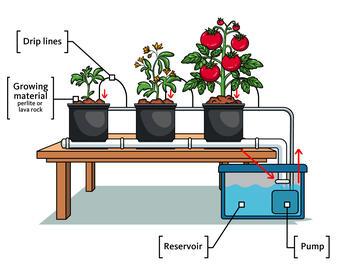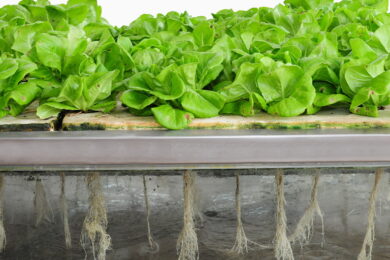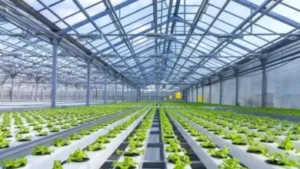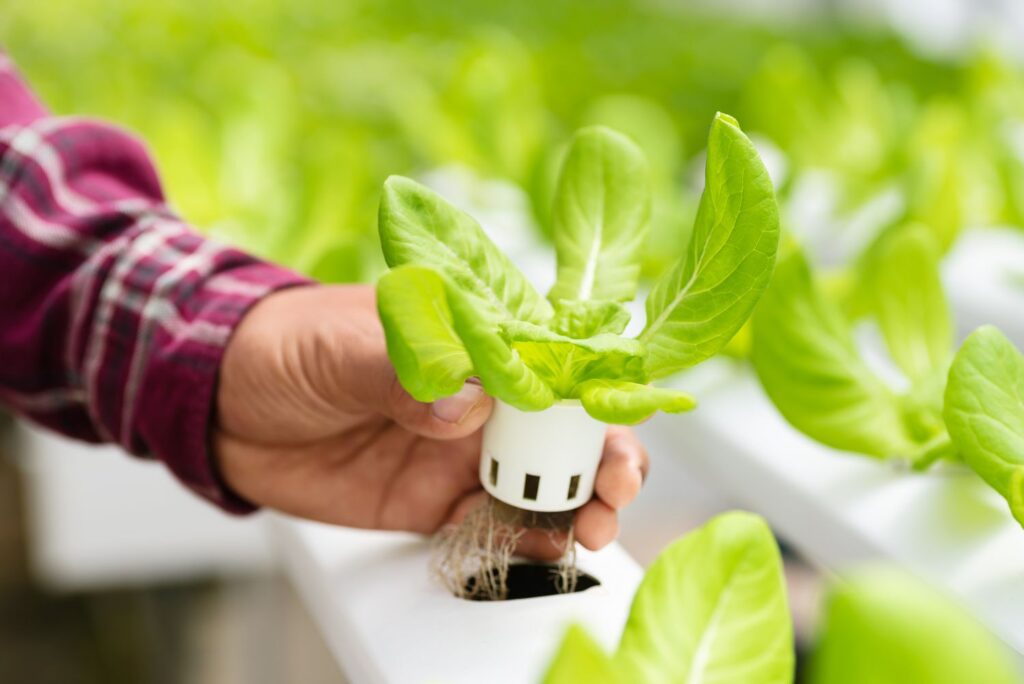Last updated on August 8, 2025
Dreaming of fresh, vibrant food year-round, even without a sprawling garden or perfect sunshine? Imagine your dinner plate starting not in a distant field, but perhaps in an urban warehouse, or even right on your kitchen counter. This isn’t a futuristic fantasy; it’s the reality of hydroponic farming, of course. It’s this wild, incredible way to grow plants—no soil required! It’s done by feeding roots directly with nutrient-rich water, often in various setups like Nutrient Film Technique (NFT), Deep Water Culture (DWC), or even Aeroponics, where roots are misted with nutrients. And honestly, it’s shaking up everything we thought we knew about where our food comes from.
Having spent years deeply immersed in the world of soil-less cultivation, from small home setups to understanding commercial operations, I’ve seen firsthand the incredible potential—and the often-overlooked hurdles. Faster growth, way less water, plants thriving in perfectly controlled environments… the appeal is huge. But like any revolutionary approach, it comes with its own unique advantages and surprising challenges. My goal with this guide is to cut through the hype and give you the truly unbiased, real-world perspective you need. Consider this your definitive guide to the 35 Top Hydroponic Farming Pros and Cons, designed to help you make an informed decision about this fascinating growing method.
Consider this your personal roadmap to understanding hydroponics. We’re going to dig right in — the good bits, the tricky bits, and everything in between. We’ll tackle your burning questions. Ready to figure out if soil-less growing is your next big thing? Let’s jump in!
Getting Started with Hydroponics: Common System Types
Before we dive deeper into the pros and cons, it helps to know that “hydroponics” isn’t a single system. There are several ways to deliver that nutrient-rich water to your plants, each with its own quirks and benefits. Here are a few common ones you’ll encounter:
Deep Water Culture (DWC)

Often a favorite for beginners, DWC systems are about as straightforward as it gets. Plants sit in net pots with their roots submerged directly into a reservoir of nutrient solution. An air stone and pump keep the water oxygenated. It’s fantastic for leafy greens and herbs because it’s relatively simple to set up and manage.
Nutrient Film Technique (NFT)
This is a popular commercial method, and one I’ve personally used a lot. Plants sit in channels, and a very thin “film” of nutrient solution flows continuously over their roots. This constant, shallow flow delivers nutrients and oxygen efficiently. It’s great for lighter, faster-growing crops like lettuce and strawberries.
Aeroponics

Considered a more advanced technique, aeroponics suspends plants in the air, and their roots are periodically misted with a nutrient solution. This method offers excellent oxygenation to the roots, often leading to explosive growth rates. It requires more precise equipment but can yield impressive results, especially for high-value crops.
The Bright Side: Key Advantages of Hydroponic Farming
When we talk about the benefits of hydroponics, it’s not just hype. There are some really solid reasons why more and more people are turning to these soil-less systems. Let’s explore the 18 distinct advantages that make hydroponic farming so compelling:
- Dramatically Reduces Water Consumption: Hydroponic systems recirculate water, using up to 90% less than traditional farming due to minimal evaporation and runoff (Source: Eden Green Technology and Wins Solutions). This closed-loop approach means every drop is maximized, preventing the significant water loss common in field irrigation. I remember setting up my first small NFT system for lettuce – a single reservoir refill lasted weeks, unlike the constant watering my outdoor beds demanded.
- Maximizes Space Efficiency: Allows for high-density, vertical cultivation, growing more food in smaller areas. This means you can get impressive yields from even tiny urban plots or indoor spaces. I’ve seen entire restaurant kitchens grow their own herbs on just a few vertical towers, right on site, proving how much can be achieved in limited room.
- Enables Year-Round Growing: Unaffected by seasonal changes, droughts, or extreme weather, allowing consistent production. You can harvest fresh produce in the dead of winter or scorching summer, regardless of outdoor conditions. It’s amazing to pick fresh basil in January, a luxury my traditional garden never offered, showing the true power of climate control.
- Accelerates Plant Growth: Direct nutrient delivery and optimized conditions often lead to faster growth cycles. Plants don’t waste energy searching for food, so they put it all into growing. We’ve consistently seen hydroponic lettuce mature in just 4-5 weeks, significantly quicker than typical soil cultivation, providing rapid returns.
- Achieves Higher Yields: Controlled environments contribute to more productive plants and increased harvests. This efficiency translates to more food from the same number of plants. My tomato plants, despite being indoors, often out-produced their outdoor counterparts by a considerable margin, demonstrating the power of ideal conditions.
- Minimizes Soil-Borne Pests & Diseases: Absence of soil reduces common pest infestations and diseases originating in the ground. This drastically cuts down on the challenges traditional gardeners face. No more battling root rot or nematodes from contaminated soil, which saves a lot of heartache and wasted effort.
- Reduces Need for Pesticides/Herbicides: Fewer pest and weed issues mean less reliance on chemical interventions. With no weeds to compete, herbicides become unnecessary, and pest control is much simpler. It’s a relief not to worry about spraying chemicals near my food, making the produce safer.
- Provides Precise Nutrient Control: Growers can fine-tune nutrient solutions to meet exact plant needs, optimizing health and output. This tailor-made nutrition can lead to healthier, more robust plants. When I finally learned to balance my nutrient solution, the difference in plant vigor was astounding – they practically exploded with growth.
- Ensures Consistent Crop Quality: Controlled conditions lead to more uniform size, flavor, and appearance of produce. Every harvest can be as good as the last, which is a big win for consistency. This predictability is especially valuable for commercial growers who need uniform produce for market.
- Facilitates Easier Harvesting: Many systems are ergonomically designed at comfortable working heights, reducing physical strain. Say goodbye to bending and kneeling for hours in the garden. My knees certainly appreciate not having to crouch over garden beds anymore, making gardening accessible to more people.
- Offers Flexibility in Location: Can be set up in diverse environments, including urban areas, arid regions, or cold climates. If you have a space, you can probably make hydroponics work. I’ve even seen compact systems running in basements, transforming unused areas into productive farms.
- Contributes to Local Food Security: Enables fresh food production closer to consumers, reducing transport and increasing availability. This means fresher food with a smaller carbon footprint from shipping. Imagine a fresh salad grown just miles from your home, available year-round – that’s the real benefit.
- Allows for Automation: Many processes (watering, nutrient dosing, lighting) can be automated, reducing manual labor. While not entirely hands-off, smart tech can simplify routine tasks. I love setting my timers and knowing the plants are getting fed even when I’m away, providing peace of mind during busy days.
- Eliminates Soil Degradation: Prevents issues like erosion, nutrient depletion, and chemical runoff associated with soil farming. This protects precious topsoil and prevents agricultural pollution. It’s a method that truly respects our land resources for future generations, a long-term win for the environment.
- Provides Cleaner Produce: Less contact with soil means less dirt and potentially fewer contaminants on harvested crops. Your veggies come out sparkling clean! I spend less time washing my hydroponic lettuce than I ever did with garden-grown greens, saving time and water in the kitchen.
- Faster Crop Turnover: Shorter growth cycles mean more harvests per year from the same space. You can get multiple crops from a single setup annually. This quick turnaround is exciting for anyone eager to see results and maximize production from their efforts.
- Reduces Land Use: Significantly less acreage required compared to conventional agriculture. This leaves more natural land undisturbed. It’s a land-efficient way to feed a growing population without expanding agricultural footprints, a crucial point for urban planning.
- Efficient Root Absorption: Roots are constantly bathed in nutrient-rich, oxygenated water, leading to efficient uptake. Plants don’t have to work as hard to find nutrients. It’s like a constant IV drip of exactly what they need, maximizing their growth potential without any stress.
The Challenges: Key Disadvantages of Hydroponic Farming
Now, let’s get real. While the advantages are compelling, ignoring the downsides of hydroponic farming would be a mistake. It’s important to understand the hurdles before you dive in. Don’t worry, we’ll face them together! Let’s examine the 17 key challenges you might encounter:
- High Initial Setup Cost: Setting up a hydroponic system, especially for indoor or commercial scale, requires a substantial initial investment in specialized equipment like pumps, grow lights, reservoirs, and environmental controls. Unlike traditional gardening which can start with just seeds and soil, hydroponics demands a more significant upfront financial commitment. My first DIY setup quickly turned into a larger investment than I anticipated once I factored in all the necessary components, making a budget crucial for anyone getting started.
- Significant Energy Consumption: Relies heavily on electricity for lighting, pumps, and climate control, impacting operational expenses. Indoor systems, in particular, can have a noticeable impact on your energy bill. I was shocked by my first electricity bill increase when I started scaling up my indoor lights, highlighting a hidden cost often overlooked by beginners.
- Vulnerability to Power Outages: Active systems can quickly fail without electricity, leading to rapid crop stress or loss. A prolonged power cut in my early days taught me this lesson the hard way; a backup plan is non-negotiable for serious growers, as plants can wilt and die in a matter of hours without circulation.
- Steeper Learning Curve: It requires a technical understanding of plant science, water chemistry (like pH and EC), and system operation. This isn’t just planting seeds and waiting. It took me a lot of reading and experimenting to really get a handle on nutrient deficiencies and pH swings, demanding patience and research before achieving consistent results.
- Demands Constant Monitoring: pH, EC, water levels, and plant health require continuous vigilance. You need to be checking your system regularly to ensure everything is balanced. I quickly learned that skipping a day of checks could mean a week of recovery for my plants, emphasizing the need for daily dedication and attention.
- Requires Regular Maintenance: Cleaning reservoirs, inspecting pumps, and system upkeep are frequent and necessary tasks. Neglecting maintenance can lead to algae, clogs, or system failures. Trust me, cleaning a slimy reservoir is not anyone’s idea of fun, but it’s essential for preventing disease and keeping the system running smoothly.
- Rapid Spread of Waterborne Diseases: A shared nutrient solution can quickly spread pathogens if one plant becomes infected. This means a localized issue can become a system-wide disaster very fast. I once lost an entire lettuce crop because a single infected plant quickly spread a fungal issue through the shared water, a tough lesson learned about system hygiene.
- Risk of Total Crop Loss from System Failure: A single point of failure (e.g., a pump breakdown, prolonged power loss, or nutrient imbalance) can quickly destroy an entire batch of plants. It’s a disheartening moment when you realize your entire effort is compromised, highlighting the fragility and interconnectedness of these systems.
- Limited Crop Suitability: Not ideal for all plants, especially those with deep taproots (like carrots or potatoes) or very tall growth habits (like corn). You can’t just grow anything. I tried growing carrots once, and let’s just say they were more like stunted radishes, emphasizing the need for specific, appropriate crop choices.
- Ongoing Nutrient Solution Expense: Requires continuous purchase of specialized hydroponic fertilizers. This is a recurring cost that soil gardeners typically don’t face. It’s not a huge cost per use, but it adds up consistently over the growing season, a factor to include in your long-term budget.
- Environmental Impact of Nutrient Production: Manufacturing and transporting concentrated chemical nutrients have an ecological footprint. The production chain for these nutrients carries its own environmental burden. It’s an often-overlooked aspect when discussing “green” farming, prompting a more holistic view of sustainability.
- “Organic” Certification Debate: Philosophical and regulatory disagreements exist regarding whether soil-less systems can truly be “organic.” This can confuse consumers and create market challenges for growers. It’s a heated discussion in many farming communities that impacts market perception and labeling.
- Potential for Flavor/Texture Concerns (if mismanaged): Improper nutrient balance can lead to less flavorful or watery produce. While capable of great taste, poor management can result in bland crops. I’ve tasted some surprisingly flavorless hydroponic tomatoes that clearly weren’t managed well, proving that technique matters significantly for quality.
- Requires Quality Water Source: May necessitate pre-treatment (e.g., Reverse Osmosis) if tap water quality is poor, adding cost. Untreated hard water can cause nutrient lockout or pH issues. I quickly learned my tap water was unsuitable and needed a filter, adding to the initial expense before I even planted a seed.
- Disposal of Used Nutrient Solution: Managing spent nutrient water requires careful consideration to prevent environmental impact. You can’t just dump it down the drain; it needs proper disposal. This adds another layer of responsibility to the grower for environmental stewardship and regulatory compliance.
- Lack of Soil Microbial Benefits: Misses out on beneficial soil microbes that can contribute to plant health and nutrient cycling in traditional systems. Some argue this impacts flavor and plant resilience. It’s a complex ecosystem that’s missing from the equation, and some believe it affects the produce’s overall vitality.
- Reliance on Technology: Success is highly dependent on the proper functioning of pumps, sensors, and environmental controls, meaning technology failures are critical. If your tech breaks, your plants suffer. A faulty sensor can throw everything out of whack surprisingly fast, causing significant crop damage and frustrating setbacks.
Key Takeaways: Hydroponic Farming in a Nutshell
So, what’s the big picture? Here’s a quick summary of the core aspects of hydroponic farming:
- Exceptional Efficiency: Hydroponics shines in its ability to conserve water and maximize growing space, making it a powerful tool for sustainable and urban agriculture.
- Controlled Growth, Predictable Harvests: You gain immense control over environmental factors, leading to faster growth, higher yields, and consistent crop quality year-round, with fewer pest issues.
- Higher Initial Investment & Technical Demands: Setting up and maintaining a hydroponic system requires a notable upfront cost, ongoing energy expenses, and a steeper learning curve compared to traditional gardening.
- Vulnerability to System Issues: The reliance on technology means power outages or equipment failures can quickly compromise an entire crop, and waterborne diseases can spread rapidly.
- Not a Universal Solution: While highly effective for many crops, hydroponics isn’t suitable for all plants, and the “organic” status remains a point of debate for some.
Who Benefits Most from Hydroponic Farming?
While hydroponics offers intriguing possibilities for many, some individuals and groups stand to gain the most from this innovative growing method.
- Urban Gardeners with Limited Space: If you live in a city apartment or have a small yard, vertical hydroponic systems can turn a tiny footprint into a productive garden.
- Commercial Growers Seeking Efficiency & Year-Round Production: Businesses aiming for high yields, consistent quality, and reduced land/water use, especially in challenging climates, find immense value.
- Educators & Researchers: Hydroponic systems provide excellent hands-on learning opportunities for students interested in STEM, agriculture, and sustainability, as well as controlled environments for scientific study.
- Anyone in Water-Scarce Regions: Where traditional irrigation is unsustainable, hydroponics offers a viable pathway to local food production, significantly reducing reliance on dwindling water resources.
- Individuals Focused on Food Security & Freshness: For those wanting fresh, locally grown produce year-round, or concerned about supply chain disruptions, hydroponics offers direct control over their food source.
Frequently Asked Questions About Hydroponic Farming
Here are quick, straightforward answers to some common questions about hydroponics:
Do hydroponic plants grow faster?
Yes, generally they grow 30-50% faster than soil-grown plants because they receive perfectly balanced nutrients and optimal growing conditions directly at the roots.
Is hydroponics cheaper than soil gardening?
Not initially. The upfront cost for equipment and setup is usually higher, but long-term operational costs might be lower due to water savings and potentially higher yields.
Is hydroponic food truly organic?
This is debated. In some regions (like the U.S.), hydroponic produce can be certified organic if it meets other strict organic standards. However, some traditionalists argue “organic” requires soil.
Can I grow hydroponically in a small apartment?
Absolutely! Hydroponics excels in small spaces, especially with vertical systems, making it ideal for urban environments.
What happens to hydroponic plants during a power outage?
Without power, pumps and aeration cease, which can quickly lead to root rot and plant stress or death, especially in active systems. Backup power is crucial for serious setups.
Do hydroponic plants use pesticides?
Significantly less, if any. The controlled, soil-less environment naturally reduces pest and disease pressure, minimizing the need for chemical interventions compared to field farming.
What’s the easiest hydroponic system for beginners?
Deep Water Culture (DWC) is often recommended for its simplicity and relatively low cost to start, making it great for leafy greens and herbs.
What are the disadvantages of hydroponic farming?
The main disadvantages include high initial setup costs, significant energy consumption, a steep learning curve, the need for constant monitoring and maintenance, and vulnerability to system failures or rapid spread of waterborne diseases.
What is the main problem in hydroponics?
The main problem is the system’s vulnerability to disruption. A power outage, pump failure, or rapid spread of a waterborne disease can quickly lead to complete crop loss, as the plants rely entirely on the engineered environment.
What are the pros and cons of hydroponics?
Hydroponics offers significant advantages like up to 90% water savings, faster growth, higher yields, and year-round production in small spaces. Its disadvantages include high initial costs, energy use, technical complexity, and susceptibility to rapid crop loss from system failures.
What is better than hydroponics?
“Better” depends on your goals. Traditional soil farming might be simpler and cheaper to start, and better for certain root crops. Aeroponics can offer faster growth than other hydroponic methods, but is more complex. The “best” method aligns with your specific needs for space, resources, and crop type.
Does hydroponics need sunlight?
Hydroponics does not require direct sunlight if artificial grow lights are provided. For indoor setups, specialized grow lights are essential to provide the necessary light spectrum and intensity for plant growth.
Which crop is best for hydroponic farming?
Leafy greens (like lettuce, spinach, kale), herbs (basil, mint, cilantro), strawberries, and vining plants such as tomatoes and peppers are among the best crops for hydroponic farming due to their rapid growth, high yield potential, and adaptability to soil-less environments.
Is hydroponic food healthy?
Yes, hydroponic food is generally considered very healthy. With precise control over nutrients, plants often receive optimal nutrition, leading to produce that is as nutritious as, or even more nutritious than, soil-grown counterparts.
What is the challenge of hydroponics?
The primary challenge of hydroponics is the demanding technical expertise and consistent vigilance required. Growers must precisely manage nutrient solutions, pH, environmental factors, and system maintenance to prevent issues that can quickly harm plants.
Is hydroponic growing safe?
Yes, hydroponic growing is safe when managed properly. The controlled environment can even lead to cleaner produce with less exposure to soil contaminants. Safety relies on using food-grade materials, proper sanitation, and safe handling of nutrient solutions and electrical components.
Do hydroponics lack nutrients?
No, hydroponic plants do not lack nutrients. In fact, they are often provided with a perfectly balanced and precisely controlled nutrient solution, which can lead to more efficient nutrient uptake and sometimes even higher nutrient concentrations in the produce compared to plants grown in inconsistent soil conditions.
Which is healthier, hydroponics or soil?
Both hydroponic and soil-grown produce can be healthy. Hydroponics offers precise nutrient delivery which can optimize specific nutrient uptake. Soil-grown produce benefits from complex microbial interactions. Nutritional content largely depends on genetics and proper cultivation practices, regardless of the medium.
Can I use drinking water for hydroponics?
You can, but it’s often advisable to test your drinking water first. While safe for human consumption, tap water can contain minerals (like chlorine or high calcium) that might affect nutrient balance or clog systems over time. Many serious growers use filtered or Reverse Osmosis (RO) water for better control.
What are the health hazards of hydroponic farming?
Potential health hazards are generally minimal and manageable. They include risks from improper handling of concentrated nutrient solutions (skin/eye irritation), mold or algae growth if sanitation is poor, and standard electrical hazards from pumps/lights. Produce safety is high due to reduced soil-borne pathogens.
The Future of Hydroponics: What’s Next?
The world of hydroponics is rapidly evolving. We’re seeing groundbreaking advancements in AI-driven climate control, allowing for even more precise environmental optimization. Robotics and automation are streamlining tasks from planting to harvesting, reducing labor needs for commercial farms. Furthermore, IoT (Internet of Things) sensors provide real-time data, enabling remote monitoring and management of systems worldwide. These innovations continually push the boundaries, promising even greater efficiency and accessibility for soilless growing.
Conclusion: How Modern Agriculture Is Changing
Hydroponic farming isn’t a cure-all for every farming problem. But it’s definitely a powerful tool as we look for more efficient, sustainable, and local ways to produce food. We’ve gone through the 35 Top Hydroponic Farming Pros and Cons, from its amazing water-saving abilities and faster growth rates to the higher initial costs and the learning involved.
It shows how clever people can be—finding new ways to grow plants from water and nutrients, even when traditional farming isn’t an option. While it brings incredible benefits, it also presents unique challenges and trade-offs that are vital to understand. The future of food is changing rapidly, with innovations like AI-driven climate control and fully automated vertical farms continuously pushing the boundaries of what’s possible. Whether you’re an experienced gardener or just starting out, I hope you’ll think about how hydroponics might fit into your world. Start small. Do your homework. And don’t be afraid to try new things. Happy growing!

